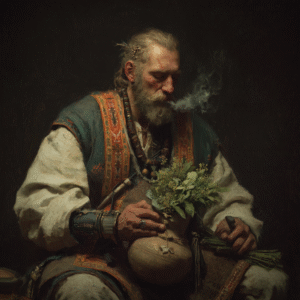Ancient Slavic Medicine: Herbs and Ancestral Wisdom
The ancient Slavs, who inhabited vast regions of Eastern Europe, developed a sophisticated system of healing deeply rooted in their connection to nature and spiritual beliefs. Their medicinal practices, passed down through generations via oral traditions, stories, and rituals, were based on a profound understanding of the natural world. This blog explores the key elements of ancient Slavic medicine, the herbs they used, and the cultural knowledge that shaped their healing traditions.
The Foundations of Slavic Medicine
Slavic medicine was holistic, blending physical remedies with spiritual and magical elements. Healing was seen as a balance between the body, mind, and the forces of nature. The Slavs believed that illness could arise from natural causes (like colds or injuries) or supernatural forces (such as curses or evil spirits). This duality led to treatments that combined practical herbal remedies with rituals, charms, and incantations.
Healers, often called znakhars (male) or znakharkas (female), were central figures in Slavic communities. These individuals were not only skilled in herbalism but also served as spiritual guides, using their knowledge to treat ailments and ward off malevolent forces. Their practices were often kept secret, shared only within families or through apprenticeship, preserving the sacred nature of their craft.

Key Herbs in Slavic Medicine
The Slavs relied heavily on the plants available in their diverse landscapes, from the forests of the Carpathian Mountains to the plains of modern-day Russia and Ukraine. Many of these herbs were believed to possess both medicinal and magical properties. Below are some notable examples:
Plakun-trava (Purple Loosestrife, Lythrum salicaria): This herb was revered for its ability to repel evil spirits and make the undead “cry” and flee. It was used in rituals to protect against malevolent forces and as a remedy for physical ailments like inflammation.
Chertopoloh (Carduus): Known for its ability to scare off evil spirits, this thorny plant was used in protective charms and to treat conditions like digestive issues.
Son-trava (Pulsatilla patens): Believed to induce deep sleep, this herb was used in potions for restful slumber or, in folklore, to cause eternal sleep or mimic death. It was carefully administered due to its potent effects.
Adam’s Head: A legendary herb with varying identities (possibly greater knapweed or lady’s slipper orchid), it was said to grant sorcerers the ability to see spirits or steal magical items from forest deities like the Leshy.
Wormwood (Artemisia absinthium): Widely used for its antiparasitic and digestive properties, wormwood was a staple in Slavic households for treating stomach ailments and warding off negative energies.
Yarrow (Achillea millefolium): Known as kryvavnyk (bloodwort), yarrow was used to stop bleeding, heal wounds, and treat fevers. Its vibrant flowers were also used in rituals for protection.
Valerian (Valeriana officinalis): Valued for its calming effects, valerian was used to treat nervous tension, insomnia, and even epilepsy, often brewed into teas or used in baths.
Chamomile (Matricaria chamomilla): A versatile herb, chamomile was used to soothe digestive issues, reduce inflammation, and promote relaxation. It was often combined with other herbs in healing infusions.
These herbs were harvested at specific times to maximize their potency, with leaves collected before flowering, roots in autumn or spring, and flowers at the peak of their bloom. The timing was critical, as the Slavs believed that plants held their strongest healing properties during certain phases of their growth.

Magical and Spiritual Elements
Slavic medicine was not just about physical healing; it was deeply intertwined with spiritual practices. Herbs were often used in rituals to invoke protection, fertility, or prosperity. For example:
Fern Flower: In Slavic mythology, the fern flower was said to bloom only on Kupala Night (a summer solstice celebration). Finding it was believed to grant the ability to locate hidden treasures or gain supernatural knowledge.
Raskovnik (Marsilea quadrifolia): This rare herb was thought to unlock any door or break any lock, both literally and metaphorically, and was used in rituals to overcome obstacles.
Healers often combined herbs with incantations, prayers, or rituals involving sacred objects like crosses, candles, or “nepochata” (magic water collected before sunrise). Colors also played a role, with red objects used for skin irritations and black for treating epilepsy.
Influence and Legacy
Slavic herbal knowledge was not isolated; it was influenced by neighboring cultures, including Greco-Roman and Asian traditions, especially during the Mongolian occupation of Russia in the 13th century. The first Russian herbal pharmacy, established in 1005–1010 at the Kiev-Pechora Lavra by a Greek monk, marked the integration of Greek medical knowledge with Slavic practices. By the 17th century, Russian medicine had documented 186 handwritten herbal manuscripts, showcasing a rich tradition of localized knowledge.
The legacy of Slavic medicine persists in modern Russia and Eastern Europe, where herbalism remains a respected practice. The Russian Pharmacopoeia, formalized in 1778, included 316 herbal monographs, many of which drew from ancient Slavic traditions. Today, herbs like Siberian ginseng (Eleutherococcus senticosus) and Rhodiola rosea are studied for their adaptogenic properties, a term coined by Russian pharmacologist Nicolaï Lazarev in 1947.
Conclusion
Ancient Slavic medicine is a testament to the deep connection between people, plants, and the spiritual world. The Slavs’ intimate knowledge of herbs, combined with their belief in the power of nature and ritual, created a healing system that was both practical and mystical. While modern medicine has largely replaced these ancient practices, the wisdom of Slavic herbalism continues to inspire and inform contemporary herbal medicine, reminding us of the enduring power of nature’s remedies.
For further reading, explore A Russian Herbal: Traditional Remedies for Health and Healing by Igor Vilevich Zevin, which provides detailed insights into Russian herbal traditions, or delve into historical ethnobotanical studies like those by Adam Fischer for a deeper understanding of Slavic plant use.
